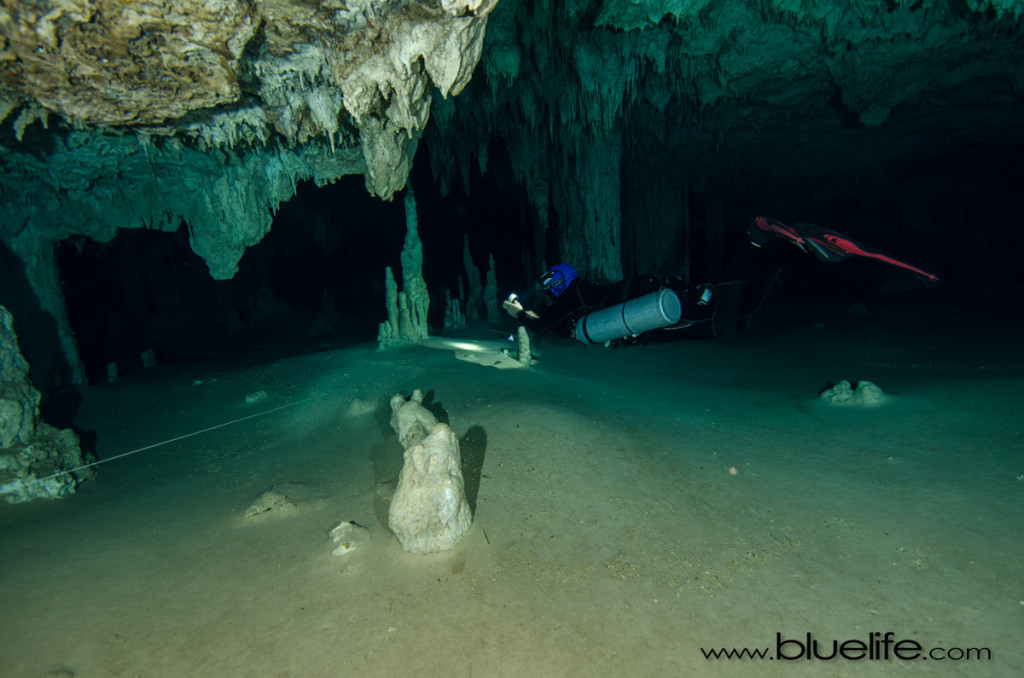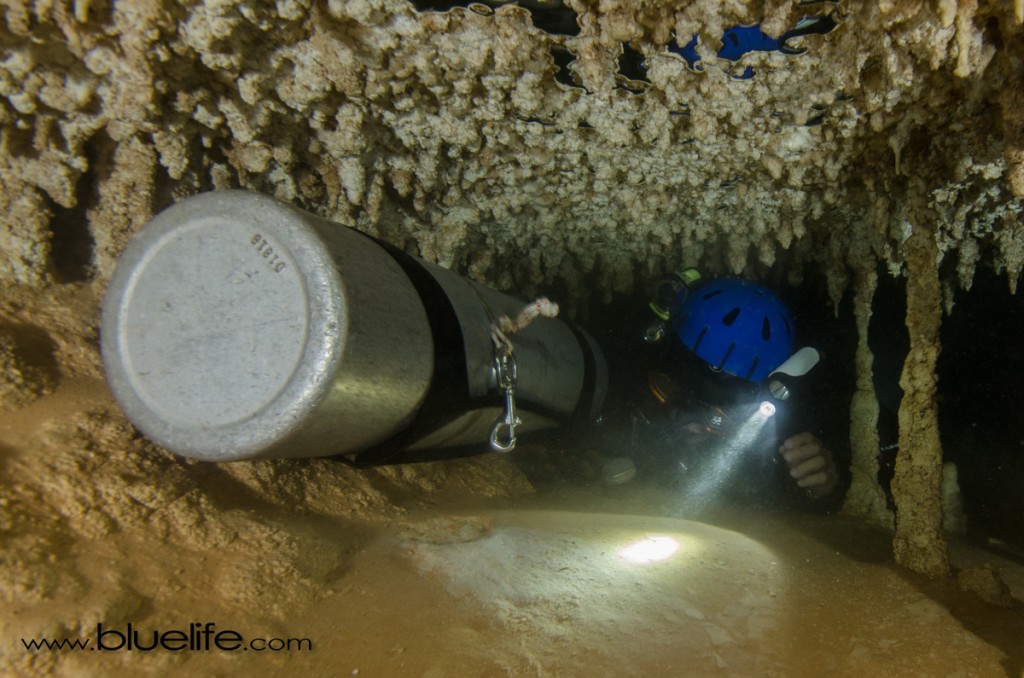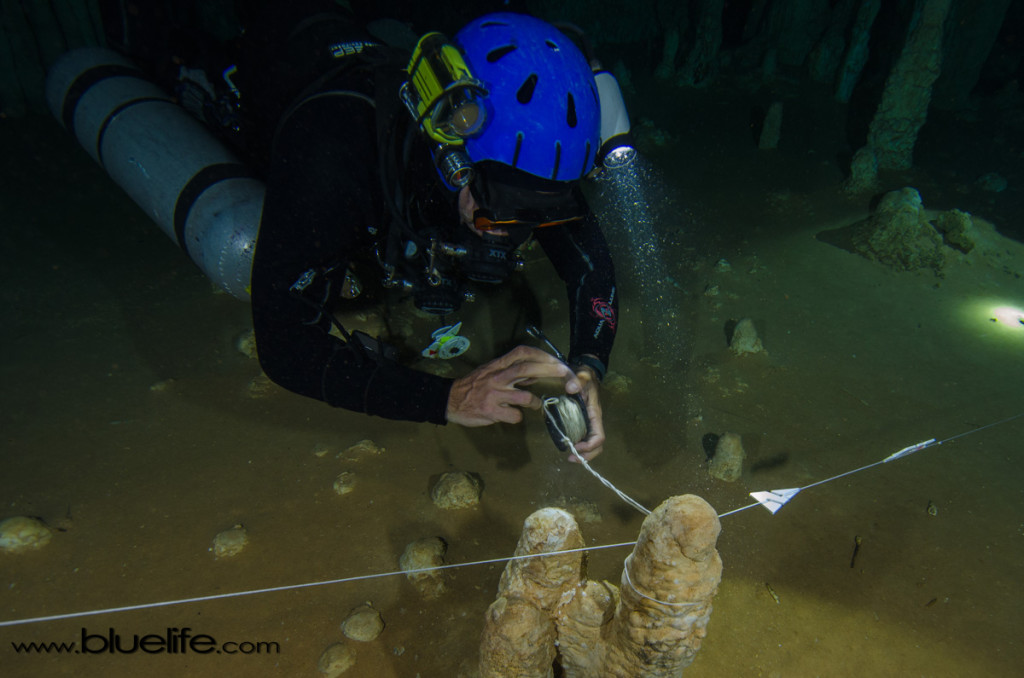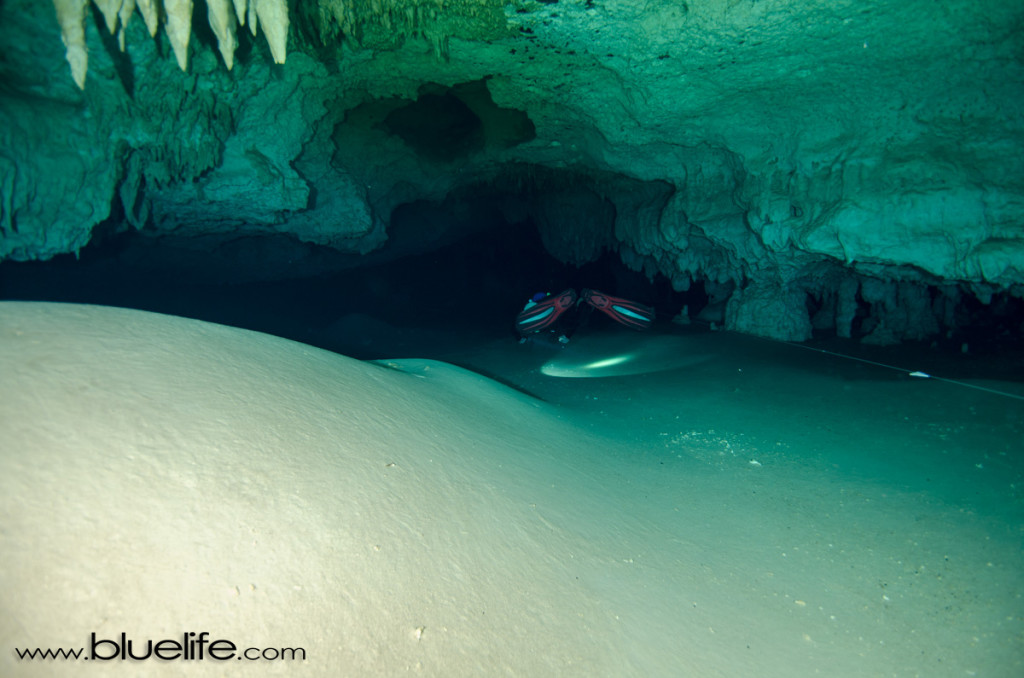News
Lost in a Cave; Becoming the Aware Cave Diver

Over the last few years, I have studied the general dive ability and attitude of cave divers. Most understand that their awareness level is not optimum but have no idea how to improve it. When teaching cave diving courses, I always use an accident analysis theory session by talking about something that happened to me at the beginning of my cave diving career in order to show how important paying attention is. I tell my students about a navigational mistake that caused one of the scariest moments of my life. I had completed about forty cave dives when I nearly quit diving them altogether.
The dive plan was for a long but shallow dive into a pretty complex system which I had not yet visited before in the Yucatan. The cave already had a permanent guideline in place and the dive plan required two jumps off of the main guideline onto secondary lines.
After a predive check, it was time to get on the main guideline which started in open water and was very easy to find as it was tied to the platform. A few minutes into the dive, I found the jumps and installed reels connecting the permanent lines so that my exit was clearly marked and there was a continuous line to the open water.
The cave was spectacular. To this day, I have seen very few caves as beautifully decorated. I was in my own little world, enjoying the amazing view while keeping the line in sight. After an hour or so of penetration, it was time to turn around and go home. I knew it was going to be more than 45 minutes before I saw sunlight but at least the view would be fantastic along the way.
At the start of cave courses I often ask my students what scares them the most about cave diving. Nine out of ten say they are more fearful of a collapse than anything else.
Collapses are extremely rare and diver error is responsible for almost everything that can go wrong during cave dives. Inexperienced cave divers forget to take this into consideration since they are used to being in total control during very forgiving dives in other environments. Unfortunately, the nature of this type of diving is that sometimes the diver will not even realize a mistake was made until hours later. Adding complacency to the mix is a recipe for disaster.
Somewhere near the halfway point of the exit portion I saw something ahead of me that froze every muscle in my body. One of my worst fears was coming true and I was not ready to handle it.
Getting lost inside a cave is a powerful fear that many cave divers posses. Although we are trained to prevent and overcome getting lost, every cave diver has thought about it at some point or another. I swam up to the unmarked T (intersection) on the guideline and could not believe it was there. A million questions went through my head as I stared at it for what seemed like an eternity. Did someone install it while I was in the cave? Was this the same guideline used during the entry? Did I get turned around somehow? How did I miss this on the way in? Which way is home? Sitting there was absolutely useless and a decision needed to be made since I was chewing through gas pretty quickly. I tried to piece things together by replaying the dive in my head but my mind was completely blank.
The dive was so beautiful that I did not pay any attention on the way in and that would now cost me. It was probable that the T was there during the entry and I simply did not see it. It did not matter. I had no idea which way would get me out but it was time to start moving as the clock was ticking. I decided to turn left.
The water was incredible, crystal clear, and that made me very uneasy. I swam along this line for a few minutes when a very powerful feeling came over me that I was going the wrong way but everything was an uncertainty. Are the jump reels just around the corner or was I just getting further away from the entrance? The water was just too clear. There was no way that I had been there before. If anyone had been diving in that section in the last few hours there would be sediment, percolation, or bubbles on the ceiling.
Turning around to head back towards the T was terrifying. Gas was getting low and there was no time for another change of heart. It had to be the other line, but even if it was, would there be enough gas in the tanks to get out?
It is counter intuitive to slow down when in a time sensitive situation but it was the only way to conserve the remaining gas which I desperately needed. Managing stress so that things don’t worsen is extremely important. Slow, stay calm and breathe slow.
The T came much sooner than I expected but there was no time to stop to analyze it again. In the best case, air was about 25 minutes away and there was barely enough gas to make it out. Compared to having zero awareness on the way into the cave, this was hyper awareness. I noticed everything, and it all looked so unfamiliar. Enormous doubts entered my head about which way was out. I was my own worst enemy but I knew that turning around was not an option. I would simply drown somewhere near that dreaded T if I turned back. I had to keep swimming. A few minutes later, I saw the second most amazing thing I have seen in my life. A jump spool with my name in big white letters was attached to the guideline. This was my way home. Now that I knew I was going the right way, all I hoped was to have enough gas to get me out.
After the dive, analyzing my memory of the incident was not helping me understand what happened. The stress I encountered erased some of the details. I knew that I had to repeat the dive for a couple of reasons. First, I would never cave dive again if I didn’t. Second, I needed to understand what I did wrong to correct it so I repeated the dive that evening. On the second dive, I found the T without much effort. It may have not been the easiest intersection to see, but I should have caught it during the initial dive.
The incident caused me to become obsessed with awareness. Taking very detailed mental notes of where things are in the cave has become a top priority. I found that awareness is crucial to the sport and has become the focal point of the cave courses that I now teach. Every one of my students is repeatedly drilled on skills that will help develop advanced awareness levels. Keeping the dive time reasonable is a major factor in maintaining awareness since long dives increase fatigue and make concentration impossible. The admiration of rocks, formations, and fossils has very low priority in order to survive cave dives. Awareness helps the diver understand where they are, how to best conserve the cave environment, what the team is doing, and what they should expect during the remainder of the dive. It is the key to efficient problem solving. Elevated awareness will also help avoid mistakes like the ones I made and assist in the development of very competent cave divers.
Article courtesy of TDI.
News
Book Review: Fire on Monroe Bravo by Fred Lockwood

Fire on Monroe Bravo is the latest book in the Jack Collier series by Fred Lockwood. Our story begins with our lead characters, Jack and Sandro, owners of Marine Salvage & Investigation Company, arriving on the Monroe Bravo Oil & Gas Platform in the North Sea. Having secured a contract for their vessel the MV Stavanger to act as support ship to the platform for TransGlobal Oil, our protagonists are on a celebratory visit.
However almost as soon as they arrive a series of explosions rock the platform, causing huge damage, loss of life and the very real danger of a massive human, ecological and financial disaster.

As the danger mounts for both our heroes and the surviving workers, Jack and Sandro will have to escape the inferno, all while trying to save the platform and the men still trapped unable to help themselves.
The disaster sets the scene for the unfolding story lines following the fate of the platform and our main characters, the police investigation into a suspected terrorist act and the actions of TransGlobal Oil as they attempt to navigate the pubic outcry and financial repercussions.
In his eighth book, Fire on Monroe Bravo, Fred Lockwood delivers an explosive thriller, with plenty of above and in-water drama, and our heroes fighting for survival, what more can you ask for?
We thoroughly recommend this read and look forward to the next in the series. For more information about his book series, you can check out the reviews of his previous books here on Scubaverse.
- Title: Fire On Monroe Bravo
- Author: Fred Lockwood
- ISBN: 979-8325324536
Available in a paperback version and for Kindle from Amazon and book stores.
Blogs
Alonissos: The complete diving destination (Part 1)

In June we were incredibly fortunate to be invited to dive in Alonissos, a small Greek Island in the Sporades island chain located in the North Aegean Sea. While I have long been a big fan of the Greek Islands as a great holiday destination, I had not had the opportunity to do any diving on previous visits and Mike and I were extremely excited to see what Alonissos had to offer both above and below the surface!

The Sporades are easily accessible via the airport in Skiathos (the first island in the chain), which is served by Jet2 flights from all major UK airports from May through October. Numerous ferries and charter boats make island hopping from Skiathos Town a breeze. After an hour boat ride, the picturesque port of Patitiri was a wonderful introduction to Alonissos, where we were met by our gracious hosts Kostas of Albedo Travel and Dias of Alonissos Triton Dive Center. Mike and I were delighted to be staying at the Paradise Hotel, aptly named for its stunning views over the sea and great location for walking to the waterfront.

Alonissos is beautifully situated in the National Marine Park of Alonissos and the Northern Sporades, the largest marine protected area in Europe. The surrounding seas offer fabulous marine life, including incredibly rare species such as the Mediterranean monk seal. They boast deep walls covered in gorgonians and sponges, stunning topography with caverns, swimthroughs and pinnacles, and the first accessible ancient shipwreck from 500BC!

In locations where historical sites have been reported, the waters are largely restricted, but with collaboration between government, underwater archeologists and dive centres, incredible underwater museums are being created for a truly unique diving experience. Alonissos is home to the first of these, the Ancient Shipwreck of Peristera Accessible Underwater Archeological Site. The chance to dive into history (along with reports of healthy reef life and amazing underwater topography) meant Mike and I were keen to get in the water.

Our introduction to the diving around Alonissos was at the Agios Georgios Pinnacles, in the channel between Alonissos and Skopelos. This fantastic site was named “The Chimney,’ and proved to have a huge amount to see. We got to a decent depth here (over 25m), and marvelled at a colourful reef wall with a wonderful swim through whose rocky walls were absolutely covered with life. As well as brilliant topography there was no shortage of macro life here. We saw numerous nudibranchs, five different species in total. The second dive at Mourtias reef nearby was a shallower dive along a nice wall with lots of crevices. Several moray eels and grouper called this site home. We enjoyed looking in the crevices for lobster and smaller benthic life, such as cup corals and tunicates.

Our itinerary allowed us two dives a day with afternoons left to explore the island with our hire car and evenings to enjoy the famous Greek hospitality. This proved to be a lovely mix of in-water and land based diversions.

The next days diving to the Gorgonian Gardens and Triton’s Cave was to be even better! These two stunning sites are nothing short of fabulous. The Gorgonian Gardens was a deep wall near to the Agios Georgios islands. The ever-present currents in this deep channel meant that the sea life was amazing … the namesake Gorgonian sea fans dotted the wall at a depth of 30 to 50 meters, getting ever larger the deeper we went. Above 30m was by no means less beautiful, with sponges, corals, scorpionfish, moray eels and some rare and colourful nudibranchs.

The second shallower dive of the day was to Triton’s Cave or the Cavern of Skopelos, on the east side of that island. The spectacular rock formations had wild striations both above and below the water making a truly epic topography. The cavern entrance was at 14m, and big enough for a buddy pair, winding up to 6m and passing two beautiful windows out into the blue. Emerging from the cavern, the light at the shallower depths and the incredible rock formations made for a fantastic gentle swimming safety stop and we all surfaced by the boat with massive grins.

Check out our next blog :Alonissos: The complete diving destination (Part 2)” to hear about our amazing dive on the 2500 year old Peristera Wreck!
Thanks to:
Alonissos Triton Dive Center https://bestdivingingreece.com/
Albedo Travel https://alonissosholidays.com/activities/
Paradise Hotel https://paradise-hotel.gr/
Alonissos Municipality https://alonissos.gr/en/
-

 Blogs2 months ago
Blogs2 months agoDiving With… Nico, Ocean Earth Travels, Indonesia
-

 News1 month ago
News1 month agoMurex Bangka Announce New Oceanfront Cottages & Beachfront Dining
-

 Blogs2 months ago
Blogs2 months agoA new idea in freediving from RAID
-

 Marine Life & Conservation1 month ago
Marine Life & Conservation1 month agoIceland issue millionaire whale hunter a licence to murder 128 vulnerable fin whales
-

 Marine Life & Conservation2 months ago
Marine Life & Conservation2 months agoThe Shark Trust Great Shark Snapshot is back
-

 News3 months ago
News3 months agoCharting New Waters; NovoScuba Goes Global with the Launch of their Revolutionary Dive Training Agency!
-

 Gear News1 month ago
Gear News1 month agoNew Suunto Ocean – a dive computer and GPS sports watch in one for adventures below and above the surface
-

 Marine Life & Conservation Blogs2 months ago
Marine Life & Conservation Blogs2 months agoBook Review: Plankton



















